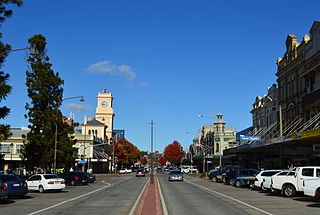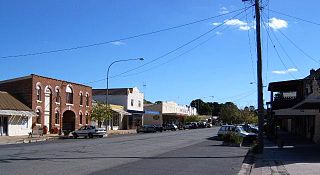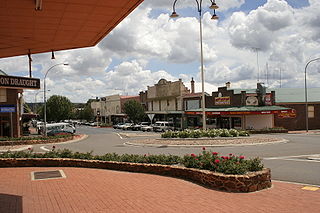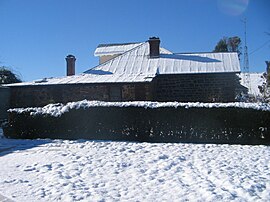
Goulburn is a regional city in the Southern Tablelands of the Australian state of New South Wales, approximately 195 kilometres (121 mi) south-west of Sydney, and 90 kilometres (56 mi) north-east of Canberra. It was proclaimed as Australia's first inland city through letters patent by Queen Victoria in 1863. Goulburn had a population of 23,835 at June 2018. Goulburn is the seat of Goulburn Mulwaree Council.

Upper Lachlan Shire is a local government area in the Southern Tablelands region of New South Wales, Australia. The Shire was formed in February 2004 from Crookwell Shire and parts of Mulwaree, Gunning and Yass Shires.

Tallong is in the traditional lands of the Gundungurra people. It is a village east of the Great Dividing Range and is located in the Southern Highlands region of New South Wales, Australia, in Goulburn-Mulwaree Council. At the 2021 census, the village had a population of 914. The town is 8.5 km from the town of Marulan and 25 km from the town of Bundanoon.

Gunning is a small town on the Old Hume Highway, between Goulburn and Yass in the Southern Tablelands of New South Wales, Australia, about 260 km south-west of Sydney and 75 km north of the national capital, Canberra.

Crookwell is a small town located in the Southern Tablelands of New South Wales, Australia, in the Upper Lachlan Shire. At the 2016 census, Crookwell had a population of 2,641. The town is at a relatively high altitude of 887 metres and there are several snowfalls during the cooler months. The nearest major centre is the city of Goulburn which is about a half-hour drive to the south-east of the town. Crookwell is easily accessible to the state capital of Sydney and also the federal capital of Canberra.

The Wombeyan Caves are caves that have formed in marble, in the Wombeyan Karst Conservation Reserve, New South Wales, Australia. Wombeyan Caves is a tourist attraction and local holiday area, as well as a reserve for endangered species, such as several species of wallaby, bird, possum, and wombat.

The Division of Hume is an Australian electoral division in the state of New South Wales.
Marulan is a small town east of the Great Dividing Range and is located in the Southern Highlands of New South Wales, Australia. It is in the Goulburn Mulwaree Council local government area and the traditional lands of the Gundungurra people. It is located south-west of Sydney on the Hume Highway, although it bypasses the town proper. Marulan lies on the 150th meridian east. It has a railway station on the Main Southern railway line. Marulan was previously known as Mooroowoolen.
The Canberra Region Rugby League competition is more commonly known as the Canberra Raiders Cup, covering the Australian Capital Territory and surrounding New South Wales towns Queanbeyan, Goulburn and Yass. The competition is run under the auspices of the Country Rugby League and players are eligible for selection in the Canberra Division of the CRL Tier 1 Divisional Championships. The Canberra district competition has an under 19s, reserve and first grade competitions.

Goulburn-Oberon Road is a New South Wales country road linking Goulburn near Hume Highway to Oberon. This name is not widely known to most drivers, as the entire allocation is still best known as by the names of its constituent parts: Taralga Road and Abercrombie Road.

Wombeyan Caves Road is a New South Wales country road linking Mittagong near Hume Highway in the east to Goulburn-Oberon Road at the locality of Richlands in the west.

Goulburn is an electoral district of the Legislative Assembly in the Australian state of New South Wales. It is represented by Wendy Tuckerman of the Liberal Party.

Argyle County was one of the original Nineteen Counties in New South Wales and is now one of the 141 Cadastral divisions of New South Wales. It includes the area around Goulburn. It is bounded by Lake George in the south-west, the Shoalhaven River in the east, and the Wollondilly River in the north-east.
The Crookwell railway line is a disused branch railway line in the south of New South Wales, Australia. It has never officially been closed. It branched from the Main South line at North Goulburn and passed north through the localities of Kenmore and Roslyn to the town of Crookwell. As of 2020, there were proposals to convert the line into a rail trail.

The Parish of Marulan is a parish of Argyle County located with the Goulburn Mulwaree local government area, which includes the towns of Marulan and Marulan South. The parish is bounded by Barbers Creek to the east, a small part of the Shoalhaven River to the south-east, and Jerrara Creek to the south. The Hume Highway and the Southern Highlands railway line run through the parish. Jerrara Road and Marulan South Road are other main roads in the area.

The Taralga railway line is a disused branch railway line in the south of New South Wales, Australia. The line commenced at a junction with the Goulburn to Crookwell line at Roslyn station and ran for a distance of 25.30 km (15.72 mi) to the small town of Taralga. The line operated between 1926 and 1957 and is one of few lines in New South Wales that has been formally closed by an Act of Parliament. Today all track has been lifted and little trace remains of the infrastructure associated with the line.

The Taralga Echo was a weekly English-language newspaper published in Crookwell, New South Wales from 1924 to 1927.

Goulburn Mulwaree Council is a local government area located in the Southern Tablelands region of New South Wales, Australia. The area is located adjacent to the Hume Highway and the Southern Highlands railway line. The estimated resident population of the area stood at 32,053 on 2021 census.
Strathaird is a locality in the Southern Tablelands of New South Wales, Australia in Upper Lachlan Shire. It is located 6.8km to the south of the township of Taralga, on the Goulburn road.
Mulwaree Shire was a local government area in the Southern Tablelands region of New South Wales, Australia.
























